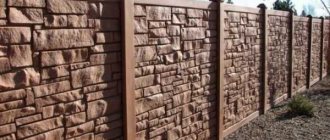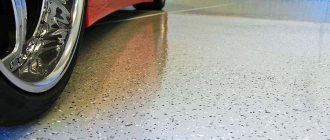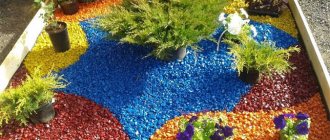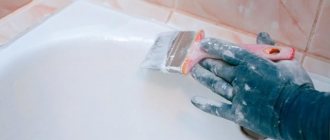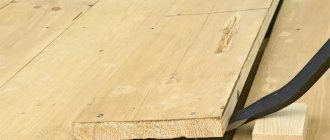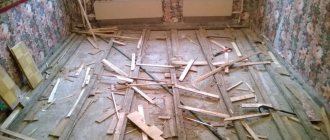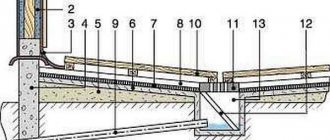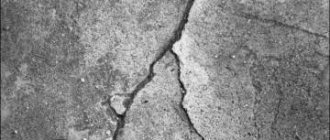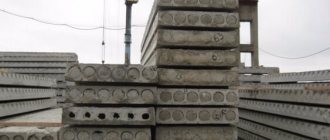Types of paints for concrete
Concrete paints are used to cover walls, foundations, paving slabs, floors and ceilings. There are paint and varnish compositions that are used only for exterior or, conversely, only for interior work. They have different properties and different performance characteristics.
From the outside, buildings and structures are exposed to various external factors, so paints in this case must have certain properties: high moisture resistance, frost resistance, wear resistance, vapor permeability, beautiful appearance and have a short drying time.
The most important parameter of materials for interior work is environmental safety and the absence of a negative impact on human health. Enamels for interior work must also resist the penetration of liquids and various mechanical stress.
Classification of paints for concrete by composition
- Acrylic paints. The most common way to treat an unpainted concrete surface is with acrylic concrete paint. It contains acrylic resins and polymer particles. The ratio of the components determines how matte or glossy the result will be. Acrylic is harmless to health, waterproof, and easy to apply. There is a huge variety of acrylic paint colors. The composition of acrylic-silicone enamels includes silicone additives - polymer components that contain silicon particles. The introduction of additives makes it possible to give paints elasticity. The consumption of acrylic paint on concrete usually varies between 170-200 g/m2.
- Epoxy paints. The two components of epoxy paint for concrete must be mixed with a construction mixer. After covering the surface to be painted with a layer of paint, it forms a protective film on the concrete. Epoxy paints protect concrete well from moisture, and their color is always rich and bright. Their main disadvantage is the small variety of color palettes. Consumption: 300-350 ml/m2.
- Vinyl paints. Vinyl enamel is used in exterior and interior work. It has a rich color and an average service life of seven years. Even an initial coat of vinyl paint is enough, so you can skip the second coat. The enamel has virtually no odor; its drying time is 2 hours.
- Polyurethane paint for concrete. Concrete floors are usually coated with polyurethane enamel. It resists exposure to aggressive environments well and also resists mechanical damage. The main disadvantage of polyurethane-based compounds is the long drying time. It lasts 2-14 days. Consumption: 160-200 g/m2.
- Water-based paints. Such colorful compositions are resistant to high temperatures. They are environmentally friendly. The surface after coating with paint will be waterproof and frost-resistant. Consumption: 550 and 350 g/m2 for the first and subsequent layers, respectively.
- Rubber paints. They are made from a water-dispersed solution, a pigment additive and acrylates. The colorful composition creates an impenetrable polymer film on the surface of concrete. The drying time of the paint is 20 minutes, and the painting itself can be done even at sub-zero temperatures. Rubber paint is often used in unheated areas. Consumption: from 400 g/m2 (for 2 layers).
Paints for concrete by type of surface to be painted
- Facade paint for concrete. The outer part of the building is covered to protect the surface from water, precipitation, dirt, fungi and dust. Enamel for treating facades must have high penetrating ability, as well as other properties of compositions for external work.
- Concrete floor paint. To paint the floor, you will need paint that is highly wear-resistant, durable and moisture-resistant. What is the best way to paint a concrete floor in a cold garage? In order to achieve the desired result, only special paints should be used. For example, paint compositions made from acrylic, polyurethane, epoxy varnishes and enamels or liquid glass can be used.
- Foundation paint. Here's what you can use to paint a concrete foundation: acrylic, alkyd, polyurethane, silicone and epoxy enamels. The choice of paints depends on the material being painted and the factors affecting it. For example, for regions with cold climates, epoxy compounds should be chosen, and silicone compounds for coating porous concrete.
- Paint for paving slabs. How to paint concrete paving slabs? To paint tiles, you need to use paints that are highly wear-resistant and waterproof. Rubber, polyurethane and alkyd paints are used to paint tiles.
- Concrete paint for blind areas. The blind area needs to be protected from precipitation, its surface made more wear-resistant and durable. How can you paint a concrete blind area? It is best to use polymer or epoxy paints and polyurethane enamel.
- How should you paint a concrete garden path? The requirements for paint for a garden path in this case are the same as for enamel for paving stones or paving slabs. You can use polyurethane varnishes, acrylic and epoxy concrete paints intended for outdoor use, and rubber enamel for painting.
Popular types of paint
Painting with stain
To paint a concrete path, it is recommended to use a special stain. These are liquid solutions that, when applied to the surface, penetrate deep into the material through micropores and pigment the concrete. There are rich and translucent shades. In terms of their composition and action, they are considered analogues of wood paints. The main feature is that with their help it is possible to imitate noble marble. The result is a protective coating that is resistant to moisture and dust. For best results, it is recommended to coat the concrete 3-4 times.
Rubber paint
When painting concrete paths with a similar product, an elastic coating is created that protects it from various influences on it. This paint is often used for painting floors in garages, tunnels and yard, where there is heavy traffic of cars and people every day. The properties of this material do not allow rubber paint to crack or peel. The service life of concrete paths with such a coating is up to 10 years.
Epoxy, acrylic solutions
The painting technology involves applying several layers, so acrylic or epoxy enamel is often used, as it is economical in consumption.
Paint for concrete paths is combined together, since their compositions and basic properties are very similar:
- They create a fairly elastic coating on concrete.
- Economical consumption, application requires only 2-3 layers.
- Their service life is the same and ranges from 2 to 5 years.
- Paints are available in a wide range of colors and shades.
- Do not fade when exposed to direct sunlight.
- What they have in common is ease of application.
Polyurethane varnish
The polyurethane varnish coating creates reliable protection on the concrete path. Transparent varnish is more often found on sale and pigmented varnish is rarely found. This material is ideal for applying to an already painted layer. This procedure allows you to extend the life of painted paths. The product is also used as a protective layer for concrete that was previously painted.
Step by step painting instructions
The old concrete base must be dry and durable, it must be processed according to the following scheme:
- Remove all detachments, clean off mold and mildew.
- Blow off the surface with compressed air.
- Fill cracks and potholes with cement-sand mortar or repair mixtures.
- If the condition is unsatisfactory, remove old oil paint using a hair dryer or grinder.
To apply paint, you can use cotton or foam swabs. Brushes with natural bristles are suitable for acid stains and polyurethane varnishes. Synthetic brushes can be used to apply all types of water-based paints.
To treat large areas, use fabric rollers or a spray gun.
Brush painting technique
When using new or old brushes, be aware that bristles may fall out during painting and remain on the finished surface.
To prevent such situations, before work, brushes must be stretched with your fingers and blown with air, then dipped in paint and checked for quality on a piece of cardboard.
To paint horizontal substrates, medium-sized flat (flat) or round brushes are most often used. The length of the bristles and the width of the tool are selected depending on the surface area, the chemical composition of the emulsion and the thickness of the paint and varnish material.
Adjustments must be made until the tip of the tool becomes wedge-shaped - it allows for more precise painting and does not go beyond the boundaries of the surface being treated.
After preparing the tool, dip the brush into the paint up to the middle of the bristles, then wring it out and begin painting work. The emulsion should be applied to the concrete surface slowly and evenly, blending thoroughly. The final pass is made parallel to the long edge of the structure.
Subtleties of working with a paint sprayer
Before starting painting, you need to adjust the nozzle to the most efficient operating mode, fill the tank with emulsion, turn on the spray gun and check the quality of the applied layer on any flat surface (sheet of plywood, cardboard, etc.).
Painting a concrete path should begin from the nearest area. The movement of the spray gun when spraying should occur in several directions - forward (away from you) and from left to right at a distance of 15-20 cm from the surface to be treated. Each subsequent layer should overlap the previous one by 3-5 cm.
Paint for concrete - how and with what to paint concrete surfaces?
Unfinished concrete is not aesthetically pleasing and attracts dust very well. To reduce the risk of contamination and improve the appearance, it is hidden under a decorative coating: concrete paint is most often used. Therefore, the topic of the properties of paint for concrete, selection rules and technology for painting concrete is always relevant.
Range
Manufacturers have saturated the market with a variety of paints and varnishes for concrete floors. In addition to the classic epoxy suspension, stores offer acrylic, polyurethane, urethane-alkyd and acrylic-silicone paints for concrete.
In general, facade paint for concrete work can fall into one of the following categories:
- waterproof acrylic or acrylic-silicone paint for concrete. Acrylic has a consumption of 0.4 kg/m2 and a service life of up to 10 years, and acrylic with a silicone additive has a lower consumption of 0.1-0.3 kg/m2 and a service life of 8-10 years;
- polymer - consumption 0.35-0.4 kg/m2 and lifespan - up to 20 years;
- epoxy - with a consumption of 0.25 kg/m2 and 8 years;
- vinyl - with a consumption of 0.2-0.25 kg/m2 and 5-7 years of service;
- lime - with a consumption of 0.15 kg/m2 and a service life of 2-3 years;
- rubber - with a consumption of 0.4 kg/m2 and a service life of up to 10 years.
Epoxy
Epoxy paint for concrete is a two-component composition that, after application, forms a protective film. Drying time is from 12 to 24 hours. For best results, apply two layers.
Pros of the suspension:
- ease of preparation - the components are mixed quickly inside a construction mixer;
- has protection against moisture - there is no need for waterproofing when using it;
- It is allowed to paint industrial concrete surfaces and floors - “epoxy” is resistant to aggressive substances (acids, alkalis);
- color saturation and brightness, durable operation.
The main disadvantage of such paints is the limited color range. But it is offset by the price and the advantages described above.
Acrylic
Acrylic paint for concrete is a water-based composition of acrylic resins and diluted polymers. The concentration of the components of the material affects the dullness or glossiness of the final result. Like epoxy dyes, they also form a protective film.
Painting the surface of concrete with acrylic is popular because it provides resistance to moisture, temperature fluctuations and high drying speed. It is used for finishing gyms, garages, outbuildings and in low-heated rooms. Apply the material yourself with a roller or spray in one or two layers. The painted surface will become dry and ready for use in two days.
Rubber
This type of decorating materials is safe for humans. Rubber paint for concrete is made from a water-dispersion solution with the addition of acrylates. And the pigment additive gives it a rich shade. After application to the surface, rubber paint for concrete forms a polymer film. The expansion and contraction of the coating prevents the appearance of cracks and chips, which cannot be said about oil analogues.
Rubber paint used for concrete is characterized by rapid hardening - it dries in 20 minutes and can withstand painting at sub-zero temperatures. At the same time, it can withstand a wide range from -50 to +60°C, and therefore it is used in cold buildings and rooms without heating. They can be used as facade and finishing paints on concrete.
Polyurethane
Polyurethane-based paints are suitable for interior and exterior use. Their serious advantage is their availability for budget repairs, but you will have to wait two weeks for complete drying. This drawback is compensated for by the lack of stickiness within two to three days after dyeing.
These dyes are used on objects where covering power is of high importance. Here polyurethane is the undisputed leader. Examples of use are car repair shops, parking lots, infrastructure exposed to chemical reagents.
Urethane-alkyd and silicone paints for concrete, which appeared on the market not so long ago, are gaining popularity. Their distinctive abilities are an ideal glossy finish and abrasion resistance.
Selection rules
When choosing what to paint concrete with, the first criterion is to take the work area. If the work is carried out indoors, then essentially any paint will do.
On the street side, use paints with anti-frost additives.
The temperature range that the coating can withstand must be greater than for enclosed spaces. We recommend paying attention to the label of the can - the manufacturer is obliged to indicate the suitability of the color for outdoor use.
When planning to paint your own home, give preference to environmentally friendly compositions. It is better to replace acid paints with acrylic ones: you will feel the benefits immediately - quick drying and minimal odor.
Tonality plays a key role. On a glossy floor, streaks and stains are more noticeable. Matte finishes are suitable for bedrooms, kitchens and dining rooms. The final and no less important criterion is the type. Each part of the house has its own dye. In the front of the house, façade paint on concrete is appropriate; the floor and walls are also painted with suitable products.
How to prepare the surface
Concrete painting is carried out only after careful preparation. When it has hardened, it is cleaned of dust, defects are sealed and make sure that the surface is completely dry. The further spectrum is determined by the characteristics of the object.
Walls and ceiling
The base is cleaned of old coating, rust and grease stains. Non-aggressive chemicals are used to combat them.
For example, caustic alkali removes old paint. Rust can be overcome by washing with water and subsequent treatment with a 15% solution of copper sulfate. And an effective helper against fat is soda ash (proportion - 500 grams of soda per 10 liters of water). Large stains are removed with nitro enamel.
Then they work with their own hands: they take sandpaper or paper and rub the concrete to eliminate roughness - this increases the aesthetics of the paint and evens it out.
Then two or three layers of putty are applied. Each tier increases paint adhesion and levels the wall or ceiling. As soon as the putty dries, it is sanded with sandpaper secured in an “iron” made of plastic or wood. Coarse layers are treated with sandpaper with a value of 60, the finishing layer is treated with paper No. 80 and even 100.
The sanded wall is re-primed. The primer must match the color used. You can find out the ideal combinations of these materials on the dye jar.
Floor
The technology for preparing a concrete floor for painting is practically no different from similar actions for walls and ceilings. The dry surface is cleaned of dirt and defects are repaired.
It is then leveled and milled, increasing the adhesion area. The preparation is completed by impregnation with soil and filling of voids with putty.
Painting technology
So, concrete paint is available, let's start painting. The technology of work is determined by the freshness of the concrete and the type of surface.
Decorative concrete
Painting concrete begins with laying a layer of paint over a small area of decorative concrete. Before the next stage, wait for the experimental zone to dry completely. If the primer or putty does not reject the color, the procedure is continued. A sprayer is used for work. After the tone has dried, the concrete is coated with 2-3 layers of matte or glossy varnish.
Acid dyeing technology is also common. When working with this dye, follow safety precautions. It will be possible to achieve the desired result only with simultaneous distribution over the surface and rubbing in with a brush. Rub it with your hands until the hissing stops. Make sure that the paint does not drip or form puddles in the seams and holes. The full effect occurs after 4 hours of contact between the solution and concrete.
The range of errors that occur during coloring varies from an unnatural selection of pigments to the use of incompatible solvents.
Walls
Before starting work, insulate the edge of the ceiling if you do not intend to paint it too. To this end, mark the perimeter with masking tape.
The sanded wall is cleaned of dust with a rag. Then they take a roller, dip it into a clean container of paint and begin to apply it to the object. The excess is removed through a painting mesh or a tray. The layer should be as uniform as possible. Painting is carried out starting from the top edge of the wall, going down, going up. The algorithm is very similar to the Latin letter W.
Places inaccessible to the roller are painted with a brush. To protect the floor from contamination, wait until excess paint drips back into the container. Re-painting the wall will help eliminate gaps. After drying, the masking tape is dismantled and the unfilled space is painted over.
Floor
The floor is painted with a brush. Apply two layers, with a drying interval between them. The procedure is allowed a week after pouring the screed.
Drying
Drying occurs naturally. We recommend maintaining the room temperature at about 20°C and humidity up to 70%.
Under such conditions, the drying time for polyurethane-based paints reaches 24 hours. If paint is applied to fresh concrete, the polymerization time of the components increases.
tehno-beton.ru
How to make it yourself
There are 20 color solutions in acrylic stains and 9 in acid stains on the market. This allows you to achieve a variety of decorative effects, create the complete illusion of marble or granite, and give concrete an unusual look for such a material. But you can also prepare your own stain for concrete at home. Varnishes, impregnations, and bases for paint mixtures are suitable as a base.
To give a decorative effect, plant components can be used:
- A decoction of old onion peels produces different shades of red-brown flowers.
- A decoction of walnut shells allows you to create a whole range of shades: from grayish to brown.
- Oak and alder bark, due to tannins, will provide a noble black uneven color, which looks especially impressive on any concrete base.
- Buckthorn is suitable if necessary to give an elegant golden hue. Unripe fruits are used.
- It is possible to use improvised materials: tea and coffee will give different shades, depending on the concentration of the additive; acetic acid, in which any metal parts were infused for 7-10 days.
- Potassium permanganate provides different shades: from brown shades to reddish and cherry. The more often the surface is treated with this impregnation, the richer the color.
Stain is the most inexpensive means of improving the performance and aesthetic qualities of any concrete base. Acid and acrylic compositions can be used both indoors and outdoors, increasing the durability of the surface and giving previously boring standard structures an original and attractive appearance.
How to care for a painted path?
In order for the applied coating to last as long as possible, it must be carefully looked after. The presence of sand and other abrasives can compromise the integrity of the layer. To prevent this, the paths should be washed as often as possible by spraying them with water from a hose or wiping them with a bulky sponge. In the latter case, you need to act very carefully.
Thus, anyone can paint concrete paths with their own hands if they wish. The main thing is to purchase the appropriate tools and materials. In this case, the end result will be “pleasant to the eye” for quite a long time.
Coloring compounds
For painting concrete, special composites are used, made from substances of different chemical compositions:
- oil and latex paints;
- enamels;
- varnishes;
- water-based acrylic and epoxy emulsions.
For example, one type of paint is intended only for interior coatings, another is used for exterior and interior surfaces, tolerates low temperatures and exposure to a humid environment, and is not susceptible to mechanical stress.
Therefore, when choosing a composition for treating concrete surfaces, you need to take into account its operating conditions:
- presence of aggressive media (acids, alkalis, etc.);
- concrete corrosion;
- influence of sunlight;
- mechanical loads in wet or dry climates;
- sudden change in temperature.
Staining
You can paint a concrete path in summer cottages using an inexpensive material - stain. They use water-based formulations with different types of active substances - acrylic and acid suspensions.
Acrylic stain for exterior and interior use can be used for impregnation of concrete walls and ceilings, floors, and paving slabs. When applied, the coloring polymer composite penetrates deeply into the pores of concrete without creating a film coating.
Thanks to this, materials treated with acrylic stains have the following properties:
- vapor permeability;
- durability;
- resistance to any precipitation.
After drying, the color becomes more saturated and resembles the shade of wet stone.
Kawabanga! Painting concrete to look like stone: lay it out on the shelves
The coloring matter, interacting with calcium dioxide, creates solid colored insoluble compounds in the structure of the cement stone. The decorative properties of acid stain allow you to imitate the texture of natural stone.
Rubber paint
Rubber paint is a solution of polymer fillers and pigments in acrylic latex. The main covering component of the composition is titanium dioxide.
After this substance dries, a durable elastic film is created on the surface of the concrete, protecting the base from the formation of cracks, fungi and mold. The coating has a matte tint, is non-toxic, washes well and has a long service life.
Epoxy and acrylic paints
- moisture resistance;
- possibility of applying layers of paint on surfaces with humidity up to 15%;
- high mechanical strength;
- abrasion resistance;
- high adhesion;
- does not contain organic solvents.
Polyurethane varnishes
Composites are divided into two- and one-component. One-component compositions set due to the humidity present in the atmospheric environment. They do not require a hardening accelerator.
How to make a colored concrete path
- Staining concrete before laying.
- Painting the finished gray stone.
In the first case, a pigment of the desired color is introduced into the concrete solution. It is worth remembering that color purity is not easy to achieve due to the predominance of gray cement. If necessary, it is replaced with white.
The advantage of the method is that the entire volume of colored stone is obtained: even in the process of abrasion of the surface, bald spots of a different shade do not form.
Painting your concrete walkway is an option for those who have already installed their sidewalk. You can change the color not only of concrete, but also of tile and stone coatings.
Features of concrete pavement
Concrete is often chosen as the main surface during exterior or interior renovations. The choice is explained by the ease of working with the materials and the properties of its operation. For exterior finishing, the material is selected based on its main positive aspects:
- Easy to care for. This includes the convenience of pouring the solution; with proper preparation, it is evenly distributed over the surface;
- Low price. Compared to other similar materials, concrete finishing is cheap;
- High wear resistance and strength. The result can withstand high loads, unlike other base materials;
- Resistance to aggressive external factors;
- Practicality, versatility. Regardless of coatings or paints applied to the surface, the coating remains in the same condition.
The frost-resistant surface is standardly used for laying external structures. This property explains the importance of choosing a dye for application to the wall. Otherwise, there is a risk of cracks forming in the decorative coating or other defects in the result. However, keep in mind that the main disadvantage of concrete is the rapid accumulation of dust on the surface. This can be prevented by laying floors - laminate or linoleum. However, paint will solve this problem faster because it completely covers the entire layer, creating a glossy finish.
Preparing for work
At the initial stage, material and tools are purchased for applying paint and varnish. When calculating the required amount of paint, it is recommended to take into account the fact that the coating should be applied in at least three layers.
This number of layers will ensure a sufficiently long service life of the protective coating.
Tools
In addition to a sufficient amount of paint, you should prepare:
- metal brush;
- painting tools;
- putty knife;
- containers in which the paint will be diluted. When doing work in the country, you can use old, thoroughly washed buckets;
- primer for concrete;
- special putty for concrete;
- colors.
Removing contaminants
If you are going to paint outdoor paths in the form of tiles, you must remove all the grass between the seams. This can be done using a shovel or any other tool. In this case, it is advisable to remove all plants along with their roots to prevent their germination in the future.
All dust and dirt are removed from the surface of the paths, old paint (if any) is removed with a metal brush, and the base is dedusted. If damage is found on the surface to be painted, for example: potholes, chips, deep scratches, they should be puttied or covered with sealant.
Degreasing
Try to remove all greasy oil stains to prevent them from seeping through the paint layer. This can be done using an orthophosphate solution. You can also use special products designed to remove various types of stains.
Primer
The prepared surface is carefully primed. For work, special deep penetration mixtures are used, intended for application to a concrete base. The primer is applied using a roller or brush in at least two layers.
In this case, you must wait until the previous layer has completely dried before applying the next one. The paint coating can also only be applied after the last layer of primer has completely dried.
Step 1: Cleaning the Concrete Floor
The first step is to clean the surface of the concrete.
- To do this, apply a degreaser and cleaner to it and leave for 20 minutes .
- After this, you need to thoroughly clean the surface with a stiff brush and then rinse it with water .
How to paint concrete on the street or install colored concrete paths in the country
Colored concrete structures are used today in landscaping areas in country houses, gardens or even city parks. But often the gray color of such products does not brighten the picture at all, but rather, on the contrary, makes the landscape gray and dull. That is why every owner who wants to give their site brightness and beauty should be interested in the question of how to paint concrete on the street?
Bright paths in your garden
Methods for painting concrete
Painting to match brickwork
Using modern construction and finishing materials, you can turn a seemingly ordinary concrete structure into a real masterpiece. With their help, a material whose price is low can be turned into noble marble, granite, natural stones, etc.
Painting concrete outside can be done in two main ways:
- Adding pigment at the stage of mixing the concrete solution. It should be said right away that the price of this method is the highest. On the other hand, this is the method that allows you to achieve the best results;
Advice. To color the solution, it is necessary to use specialized pigments that can dissolve in plain water. Often, white cement is used to create colored mixtures. With this material you can easily achieve the desired color of the paths.
- Painting the surface of ready-made paths. For this purpose, specialized paints for outdoor concrete or other finishing materials are produced that can be absorbed into finished concrete surfaces to a depth of several millimeters. With these materials you can paint not only the paths themselves, but also the floors on verandas, basements, stairs and fences.
Advice. In order for the color of the paths to be more saturated, the coating should be applied in two layers.
Painting the concrete mixture
The most obvious advantage of this method of adding color is through-coloring. This means that even if your tracks are damaged or their top layer is erased during use, their color will still remain the same.
The cost of such coloring is quite high, primarily due to the fact that to obtain a deep, saturated color it is necessary to add a lot of coloring agent to the solution, and its price is high.
In the photo - colored pigments
This method has found wide application in the production of paving slabs, curbs and paving stones. Well, if you fill the garden path with your own hands using this method, then the owners can completely forget about the need to periodically touch up it.
In order to prepare a colored solution, you will need the following tools and materials:
- Containers for mixing construction mixture;
- Shovel type;
- Master OK;
- Dry mixture of white cement;
- Sifted sand;
- Crushed stone;
- Water;
- Pigment of the desired color.
Colored mortar in the production of paving slabs
The instructions for preparing the solution provide for a ratio of the proportions of water, sand, crushed stone and cement of 1/3/4/1.
The process of preparing the solution should be performed as follows:
- Water is poured into a pre-prepared container for mixing the solution;
- After this, cement is poured into the water and the mass is thoroughly mixed;
- During the mixing process, sand is added to the mass;
- Next, crushed stone is poured in, while stirring the solution does not stop;
- After the crushed stone we fill in the colored pigment. The amount of this product should be sufficient to obtain the required shade.
Thus, we get a solution that can be safely poured into the pre-prepared formwork of your garden path. After the solution has completely hardened, you will get a colored concrete path.
Painting a finished concrete path
If you are looking for an answer to the question of how to paint concrete on the street, if the path is already ready, then the instructions for this method were created especially for you.
The cost of adding color to concrete is much lower and for the job you will need the following materials and tools:
- Acrylic stain or water-based stain;
- Film to protect trees and greenery near the path being painted;
- Pressure paint sprayer;
Note! This device can be rented.
- Sealant for concrete;
- Paint roller.
For painting it is better to choose a small volume spray gun
Painting concrete outside can begin after preparing everything necessary and is carried out in accordance with the following step-by-step instructions:
- First, the path must be cleaned as thoroughly as possible. It is necessary to remove from its surface all debris that could interfere with the uniform, widespread and thorough application of the coating. After this, the surface must be washed.
Advice. If greasy stains are found on the surface, specialized detergents should be used to remove them.
- Calculate the required volume of paint and varnish material by measuring the width and length of the path and calculating the area of the surface to be painted;
- Use film to cover trees, bushes, flower beds, and building walls located next to your concrete path. This measure is necessary to ensure that everything around is not painted along with your path;
- Now the paint you have chosen for finishing needs to be poured into a paint sprayer. In order to apply the coating evenly, you must read the instructions for the spray gun;
- It is necessary to start working with the paint sprayer from one of the corners of the surface, holding the device at a height of about 50-60 cm above the path to be painted;
- In order to achieve the best quality and richness of the finish, painting should be done in several layers. Before applying each subsequent layer, the previous one must be allowed to dry well for several days;
- The dried, painted surface should be coated with a specialized sealant, applying the product using a short-nap roller.
Finally
Bright design of the path
Using specialized paints or pigments for coloring concrete mortar, you can create beautiful and bright concrete paths in your own garden, which will not only look aesthetically attractive, but will also transform the entire area, adding fabulous notes to its atmosphere (find out here how to degrease before painting this or that material).
Well, to learn even more about how you can paint street concrete, the video in this article will tell you.
Add to favorites Printable version
nashaotdelka.ru
